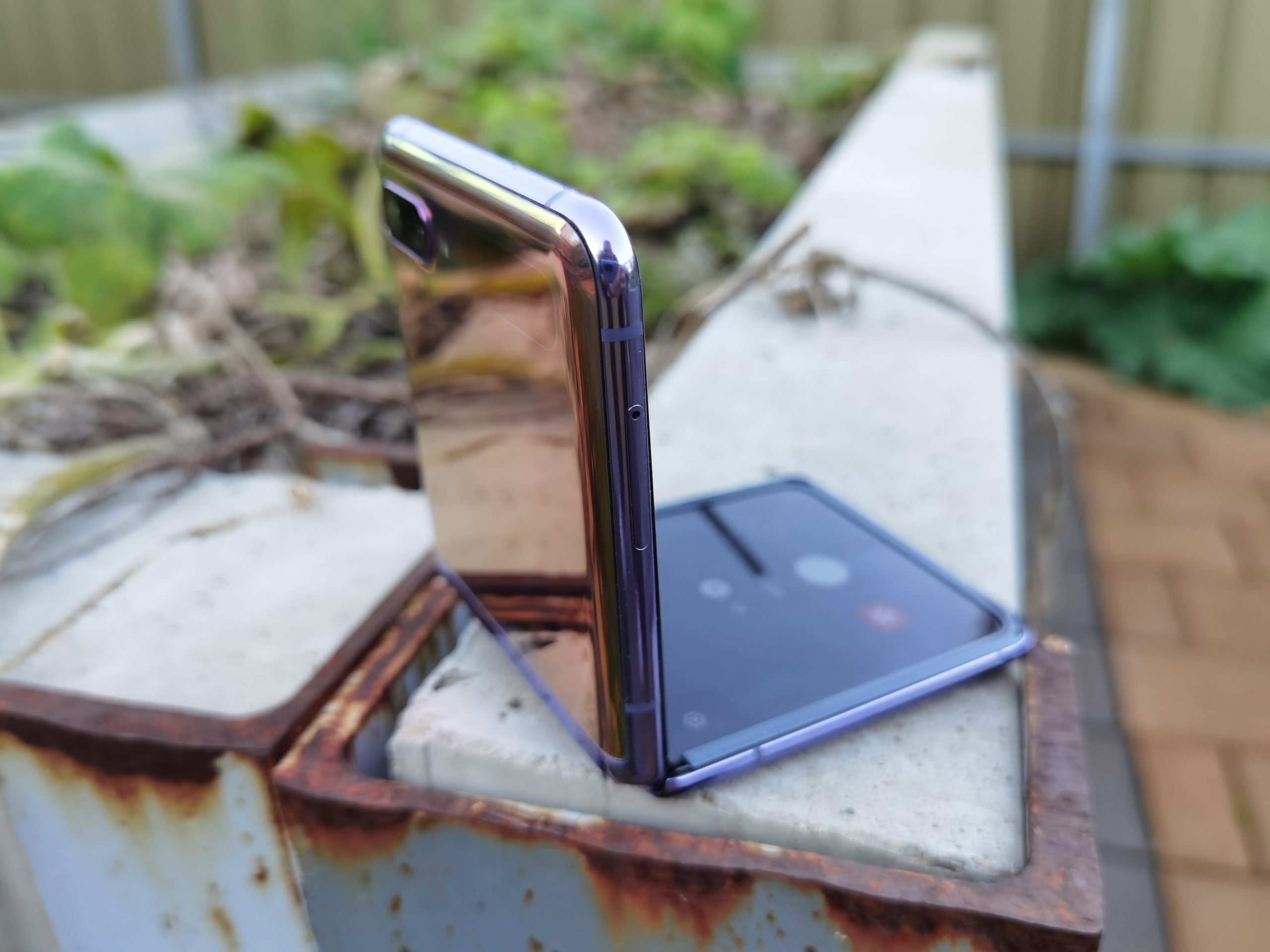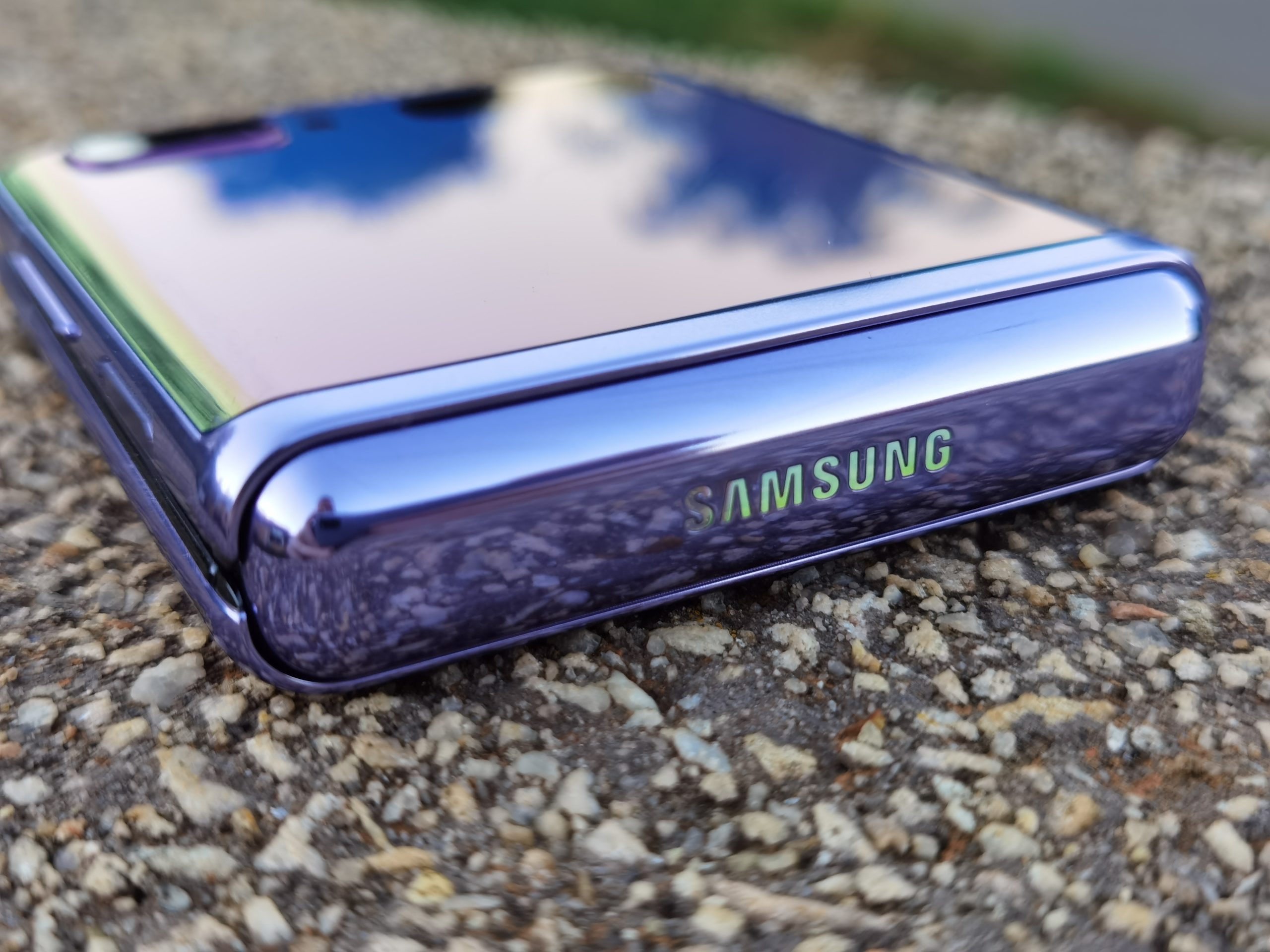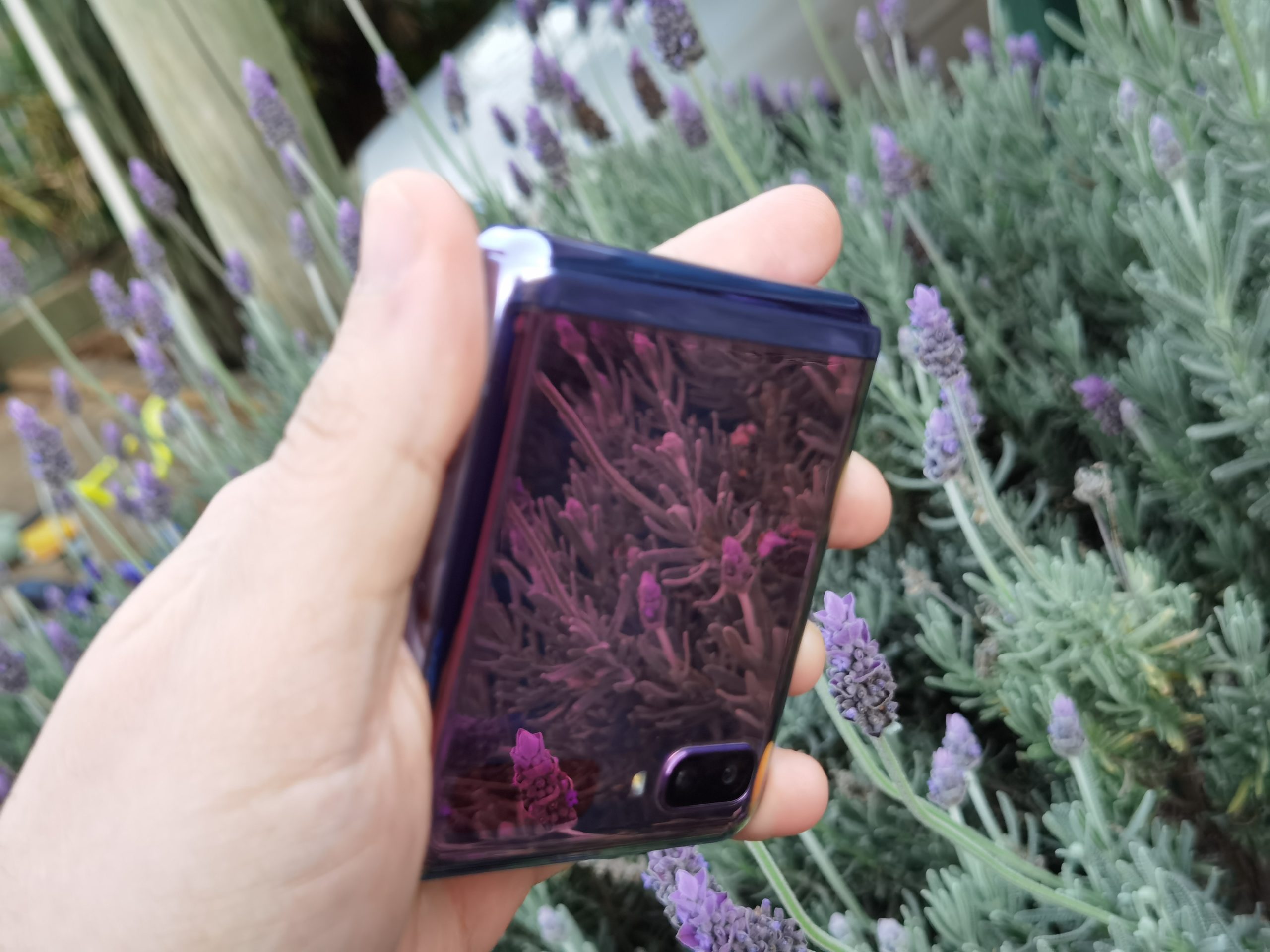For many users, Samsung “is” Android so when Samsung delivers an innovation it has an impact. The first attempt at a folding phone from Samsung was very good but had some drawbacks — primarily the soft screen. The Galaxy Z Flip brings a new twist to an old friend, the flip phone.
We’ve already taken a quick look at the device a couple of weeks ago and noted that it feels quite normal very quickly. Now it’s been in use for a couple of weeks there’s a lot more to say about the phone, its features and its specs.
The hardware and design
As we’ve already explored, there are some areas of the Z Flip specs that — with particular reference to the price — don’t meet the market expectation, but in this case, it’s not a deal-breaker, you are paying for the form factor, not what is within.
- 6.7-inch (when unfolded) screen with a 1080 x 2636 pixel resolution (~425 ppi density)
- Plastic front, Gorilla Glass 6 rear
- Android 10 running Samsung One UI 2
- SD855+ and Adreno 640GPU
- 256GB Storage and 8GB RAM
- 3,300mAh battery with 15W fast charge
- Connectivity: Connectivity: 802.11 a/b/g/n/ac, Bluetooth 5 BLE, NFC and USB C
- Side mount fingerprint sensor
- Dimensions Unfolded: 167.3 x 73.6 x 7.2 mm, Folded: 87.4 x 73.6 x 17.3 mm and weighs 183g
- LTE network connection, no 5G
The specs really only tell half the story, because the Z Flip isn’t about the top specs, it’s about innovation. So let’s start by taking a look at the screen and the user experience that it delivers.
The folding display
There are some good points and some concerns to run through here. The screen runs 1080 x 2636 pixel resolution at ~425 PPI. It’s pretty easy on the eyes, with great colour — bright and remarkably vibrant — reproduction and extremely responsive touch. Even outdoors in bright (it was a fleeting moment) sunshine, a particular highlight for me was the responsiveness of the automatic brightness.
But you’re not reading this to hear about the resolution, so let’s talk about the folding screen and mechanism. The actual folding motion is smooth and solid, it feels like it was built to last. There’s a distinctly firm clunk when you close the phone from a call and the hinge is firm enough that you’re not likely to accidentally open the phone. That also means that it’s not easy to open the phone one handed.
If you sit the phone open on a 90 degree fold, it holds its place without needing to be propped open which opens the door to new use options. One that immediately presents is the option to set your phone on a table or desk folded to 90 degrees, engage split screen mode and watch the streaming media of your choice. The other we’ll explore later as we take a closer look at the camera setup.
This isn’t a perfect folding device, there are some areas of concern to address. The first one which a lot of people have asked me about is the crease on the screen. Yes, you can see and feel it when you look for it. In daily use, I just don’t notice it and that’s for a variety of reasons.
The crease is right in the middle of the screen, I know this is an obvious statement but it’s important. Most people use their phones one handed and that means your scroll range is not huge. Personally, while my thumb can reach to run over the crease I generally don’t go that far or feel it.
The other factor that minimises the impact of the crease in daily use is the colours and vibrance of the screen. It’s another — typical of Samsung — vibrant screen and they’ve done an excellent job of choosing colours to minimise how visually prominent the crease actually is. That still leaves my main concern with the Galaxy Z Flip: how long will it last?
There are a couple of items to explore with the longevity of the Z Flip, let’s start with a notable omission from the specs. It lacks an IP rating which is pretty common in the current generation of phones. So the security of the device even being splash proof just isn’t there, more concerning for some users as you just can’t avoid getting wet from time to time.
I’ve been saving the biggest worry for last here. I’m just not sure how long the screen will last. We’ve seen that the Z Flip has a few issues in terms of durability and while I haven’t seen them directly, it’s still a concern. I’d really like to revisit this discussion in about 6 months time to see how many Z Flip devices have been returned for warranty or repairs on the screen or hinge (or if Samsung let us hang onto this for a longer term review).
Charging options
Another area of daily use that seems to be a bit of a battleground at the moment is charging. The Samsung Galaxy Z Flip has both 15W fast charging and wireless charging and this is important for this device. It was said in our first impressions post that the Z Flip is about having the latest and greatest, so while the fast charging is good it would have been an oversight by Samsung to omit wireless charging from the specs.
Perhaps the only let down with the charging is the fact that the wired fast charge isn’t really that quick. It works, it’s faster than a standard charger but it’s not mind-blowingly fast like the P40 Pro or the OPPO Find X2 Pro.
Let’s be honest, we can’t blame Samsung for playing it safe with batteries can we?
Battery life
Normally I wouldn’t delve into the battery life of a phone too deeply in the current generation. They’re all quite capable but in this case, I need to because there are users who are going to be unhappy if they buy the phone. The 3,300mAh battery is acceptable, but nothing more. On an average day, I was plugging in at night with anything between 9 and 17 per cent battery remaining. On a big day (extra screen on time, lots of calls etc) I was looking for power by about 3 – 4 pm regularly and at times, very thankful for the top-up charge that my phone got while I’m in the car.
Office workers will be fine, just keep a charger on hand and give it a top up for 10 or 15 minutes twice a day. If you’re a road warrior then make sure you’ve got that car charger in your vehicle. If you’re not conscious of your battery use, users of the Galaxy Z Flip are likely to get caught out with low battery more than once.
The software is very Samsung
Now that’s not a bad thing, in fact for many users it’s a bonus. The comfort and familiarity of Samsung’s One UI 2 make switching between devices very easy. The updates to One UI over the past 18 months have made it one of the best “skins” for Android available. I’m saying skins because I’m not considering stock or near-stock experiences in that realm. One UI 2 has gone a step further in removing much of the invasiveness, making it a much better user experience.
The UI is really responsive, smooth and predictable in its behaviour. For what is being delivered, the amount of memory gives the Z Flip a really nice performance edge over some other phones edging at the top end of the market. Personally, I’m a fan of having a stock-ish Android experience (Pixel or OnePlus being my far preferred options) but Samsung’s UI is not something that I find offensive and can easily use every day.
Flashing back to the first impressions post: It quickly feels normal to have the folding phone, when it’s open, it operates like any other Samsung-based Android phone.
The Camera is really good, but not great…
Again, the specs of the phone aren’t bleeding edge. If you want that, head to your local store and buy an S20 variant or if you’re after camera alone, the Huawei P40 Pro. Don’t get me wrong though, it’s difficult to really fault the cameras on the Z Flip, they’re just not quite as sharp in detail and definitely a step down from other phones in the ultra-premium market tier.
The areas that really matter in terms of the camera specs are the fact it’s a dual-camera setup versus the 3 and often 4 camera devices leading the way. The primary camera is a 12MP f/1.8 aperture and sporting Optical Image Stabilisation (OIS). The secondary lens is an ultra-wide 12MP sensor f/2.2 aperture. While there is a selfie camera — for the number crunchers out there — offering a 10MP, f/2.4 aperture – it really doesn’t matter for reasons I’ll go into shortly.
There were a couple of little niggles with the camera, not total deal breakers but brining the potential of disappointment with some photographic results. The areas where the Galaxy Z Flip camera fell down for me were:
- The zoom isn’t great, it’s a little unstable when taking photos and delivers a grainy image
- The autofocus can be disappointingly slow at times
- Low light shots were ok, not good, not bad, just OK
- Night mode is better than automatic, but really nothing to write home about
It’s mentioned above but it’s worth detailing a little more. Night mode is present in the menus, it’s somewhat hidden under “more” settings rather than having its own quick access item. It almost feels like this is a token effort to say “we included night mode” but it is better than a slap together job. It does a decent job and when you couple it with the secret weapon that the Z Flip has to ensure your phone is perfectly still while taking a photo, you can get some good results.
The Z Flip has a trick to share
Where the Z Flip excels for photos is when you use the Flip to your advantage and let Samsung’s well optimised post-processing work its magic. So what do I mean by using the Flip?
Rather than using the selfie cam with friends, you can really easily frame your rear camera photos. Once you’ve done that set the timer, pose and BOOM – Instagram ready. This means you’re able to use the better quality camera for the vast majority of the time resulting in better photos. It does take a little getting used to versus the selfie cam, but the results are pretty good as a general rule.
The end result of your efforts will be a consistent and eye-pleasing, distinctly “Samsung” photo. The post-processing that Samsung offers on their camera phones has been consistent for a number of years, without — usually at least — going overboard they smooth out some facial features, sharpen edges and enhance colours. Perhaps lacking a touch of sharpness compared with the likes of the P40 Pro but a sold and predictable result all the same.
Are foldable phones ready for the masses?
There’s a lot about the Samsung Galaxy Z Flip that’s worth looking at. The form factor is excellent, the physical size is really nice making it easy to pocket — even in some grossly inadequate pockets in women’s pants — and it works really well as a phone should when it’s unfolded.
The technology still feels like it’s the first generation, but more version 1.4 and almost ready to go to version 2.0 and that leaves some questions and concerns to be answered. We’ll undoubtedly get those answers over the coming 6 to 12 months by the early adopters on issues such as:
- Will the hinge last in the real world?
- Will the screen stand the test of time?
- Is the battery going to hold up for heavy users? *hint* probably not.
- Will the specs of the device end up being a disappointment for buyers?
Let’s put all of that in perspective, this phone isn’t for everyone. This phone isn’t for the tech enthusiasts either. The Samsung Galaxy Z Flip is a really expensive phone costing $2,199.00, putting it out of reach for a lot of people.
Should you buy one?
If I was required to answer yes or no, I’d give you a no. Not because the phone is bad or I actually believe it will ultimately be a disappointment, just because there are those questions that cast some doubt over the potential lifespan of the device. You’ll undoubtedly (although no promises have been made by Samsung) get at least one, probably a couple of major OS updates and you would hope security updates for the lifespan of the phone.
The battery life is acceptable but doesn’t set any records. It’s complemented by the fast charging option via wired charger or wireless charging convenience to keep your phone topped up during the day. Given the cost, I don’t think it would be unreasonable to provide a wireless charging pad with the phone.
Would I buy one?
The short answer is not quite yet. The phone is good, really good. But I just have too many niggly concerns about the durability of the device. There is a market segment that will buy one without hesitation. If you love Android and having the latest gadgets plus, have the budget for a Samsung Galaxy Z Flip, then absolutely – have at it!
It’s a really good phone at all things, the screen feels normal and when unfolded the phone operates as it should. The phone’s form factor also opens it up to some neat little party tricks for viewing and photography.
Make no mistake, whipping this thing out is a serious flex!
When the next generation of foldable phones arrives, once the technology is well proven in the real world I think you’ll be hard pressed to find anyone with a legitimate push back against folding phones. They are the future and the future looks bright.

























Great review!
Another special feature is the use of Snapdragon chipset. This is the only such Samsung phone (I think) ever sold in Australia. Even my Galaxy Note 1 had an Exynos chipset.
Based on current reviews of S20 Exyons (poor battery life, overheating, picture quality), the use of a Snapdragon chipset makes it a big deal for Australia and other regions.
they do mix it up a bit with SD vs Exynos in Oz. e.g. my S5 had an SD801